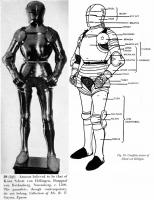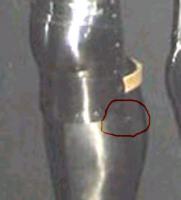доспех из частной коллекции не вылезал, и в 2003 был продан в Америку за 2 с лишним миллиона фунтов.
Лидс цену перебить не смог, так что вряд ли хорошие фотографии маожно будет найти
A full suit of armour c.1495
The suit of armour is one of only three homogeneous transitional German armours in the world, and the
earliest of the group.The owner, whose name was supplied to the Committee but is withheld from the
report by request, applied for a licence to export the armour to a purchaser in the USA, whose name was
also supplied to the Committee but is again withheld from the report by request.The value shown on the
export licence application was £2,708,609.54, which represented the agreed sale price. In the event of a
UK sale, the price would have been £2,801,817.24 including agent’s commission and VAT.
The Master of the Royal Armouries, acting as the Department’s expert adviser, objected to the export of
the armour under the second and third of the Waverley criteria. Because of its exceptionally elegant form
and status as the definitive example of transitional German armour, it was of outstanding importance to
the study of the history of design and manufacture of armour.
The expert adviser explained that, between 1490 and 1510, there was a change in the styles of armour
worn throughout Europe, with the most distinctive styles, the Italian and German, changing most radically.
Italian armourers adopted the fluted decoration and symmetrical forms previously confined to the
German school, and German armourers abandoned the graceful Gothic style with its angular forms and
fluted decoration and adopted the bold, rounded forms previously associated with Italian armourers.This
period in the development of German armour was known as the ‘transitional period’, between the Gothic
style of the fifteenth century and the ‘Maximilian’ style that dominated German armour production in the
first half of the sixteenth century.
This armour had been made in the important armourmaking centre of Nuremberg in about 1495 (the
guildmark was stamped inside the backplate) and was decorated on the breastplate with the arms and
crest of Schott von Hellingen, one of the most ancient knightly families of Franconia, which could be
traced back to the tenth century. In 1497, Kunz Schott von Hellingen was appointed Burggraf of
Rothenburg, a castle which defended the trade routes to the east of Nuremberg. From Rothenberg he led
the Franconian knights in a bitter struggle against the city of Nuremberg.The city put a price of 2,000
guilders on Kunz’s head and he was outlawed by the Emperor Maximilian I in 1499.After more than 20
years of almost incessant fighting, the feud was settled in 1525 and Kunz was given safe conduct to pass
through the city, to be attended by some of Nuremberg’s famous doctors in the Heilsbronner Hof. He
died there in the next year, and in the chapel there as late as 1757 was a tablet on which was inscribed in
German: Anno 1526, on Monday after the Holy New Year’s Day died the noble and staunch Conrad Schott,
Amtmann of Streitberg, whose soul is in the care of God.
The armour had been preserved in the Nuremberg arsenal (the Zeughaus) until it was looted during the
Napoleonic wars. It then passed into the celebrated collection of the Counts of Erbach in Oldenwalde, and
was first mentioned there in the guidebook to the armoury published in 1812. It was purchased privately
by William Randolph Hearst in 1930, taken to New York for restoration by Hearst’s armourer and then
returned to St Donat’s Castle in Wales where Hearst kept his armoury. It was purchased privately before
1952, and had remained in private hands ever since, except in 1963 when it was loaned to the exhibition
The Art of the Armourer at the Victoria & Albert Museum.
20
Page 27
Department for Culture,Media and Sport: Export of Works of Art 20022003
The expert adviser concluded that the armour was the only known nearly homogeneous transitional
German armour made before 1500, and the earliest known nearly homogeneous German armour in the
UK.The suit had been published in Claude Blair’s European Armour, which remained the standard
reference book on the subject, and had become in effect the definitive example of the type, thus making it
of outstanding importance to the study of armour design and manufacture. It was also of exceptionally
elegant form, made just before the period when surface decoration, either embossing, etching or gilding,
came to dominate the artistic aspect of armour, making it of outstanding aesthetic importance.
We heard this case in July 2002, when the suit of armour was shown to us.
The applicant said that the suit was not directly associated with British history, national life or a major
historical event. Equally, it was not of major importance for local history or part of a collection of the
greatest historical significance. He said that the armour could not be judged as being of outstanding
aesthetic importance because it had been added to, and was not preserved in or near its original
untouched condition.The applicant also said that the armour added nothing more to what could be
drawn from examples already in the UK, and that there were in fact two better examples of transitional
armours in the Wallace Collection and at the Kelvingrove Art Gallery and Museum in Glasgow.
The applicant also stated that there were good reasons to doubt the validity of the identification of the
armour as having belonged to the German warlord Kunz Schott von Hellingen.The identification was
based on the existence of a simple and somewhat crudely engraved Schott family coat of arms at the top
of the breast plate.The presence of a coat of arms in such a prominent location on an otherwise plain
armour was not characteristic of the period and in fact was found on no other armour of that date.
The fact that the arms were engraved or incised into the steel rather than etched, led him to believe that
they were added later, probably in the eighteenth century, as part of the desire to identify armours with
local heroes in the Romantic era.
We accepted that it was a matter for debate whether the suit had been made for von Hellingen, and that
it was possible that the arms had been added at a later date, when the armour had been displayed in a
Hall of Heroes. However, we agreed that the suit was an outstanding example of transitional armour,
representing the earliest example of its type, and therefore of major importance for the study of the
history of the design and manufacture of armour.
We concluded that the armour met the third Waverley criterion.We therefore recommended that a
decision on the export licence application should be deferred for a period of three months to enable an
offer to purchase to be made at the recommended price of £2,801,817.24.We further recommended that,
if at the end of the initial period of three months there was a potential purchaser who showed a serious
intention to raise funds with a view to making an offer to purchase, the deferral period should be
extended by a further three months.
21
Page 28
Department for Culture,Media and Sport: Export of Works of Art 20022003
We were informed by the Royal Armouries, Leeds, of a serious intention to raise funds with a view to
making an offer to purchase the armour.A decision on the export licence was deferred for a further three
months.At the end of the further threemonth period, no offer to purchase had been made.An export
licence was therefore issued.




















